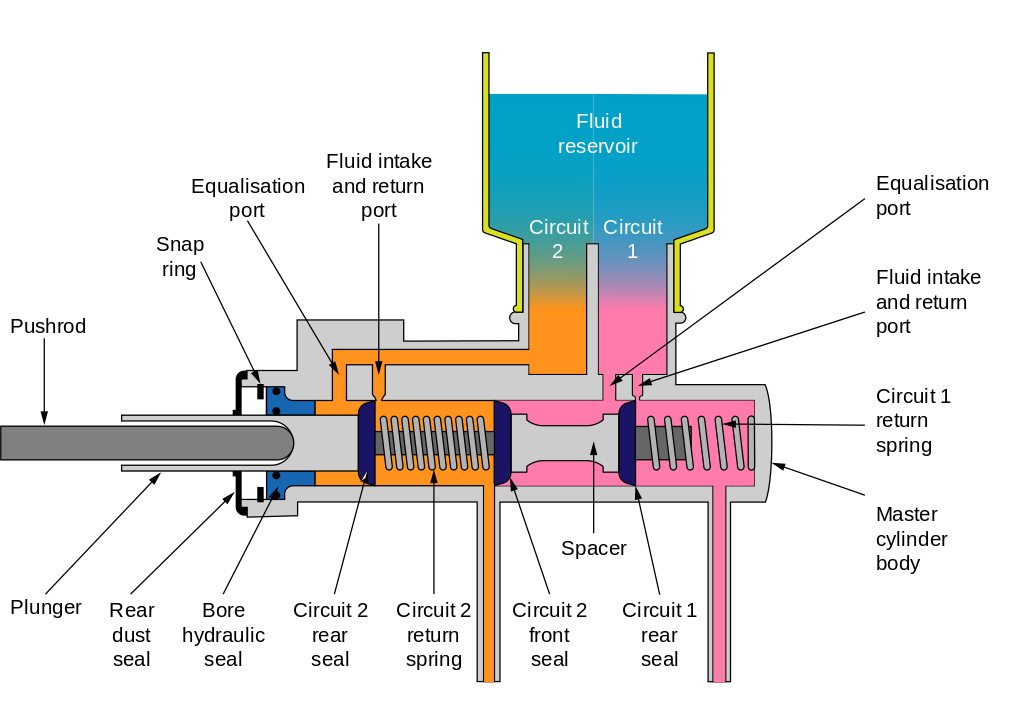Car Fundamentals: Brakes

A car's braking system helps it slow down smoothly and safely. It uses a pedal inside the car to press special pads inside the wheels. The brakes create friction, like rubbing your hands together to warm them.
There are two main types of brakes:
- Disc brakes, which work like squeezing a spinning plate between two pads
- Drum brakes, which are like pushing pads against the inside of a spinning drum
Many cars have both types, with discs in the front, drums in the back, or sometimes disc brakes on all four wheels.
Let's look at the parts involved.
Master Cylinder
The brake pedal in a car works like a pump handle for the brakes. It connects to a master cylinder that controls the braking. The master cylinder is sometimes split into two systems, so if one part fails, the other keeps at least two brakes working. Pressure regulators make sure all the brakes get the same power at the same time.

Some vehicles use power brakes to help increase the pressure from the pedal. They use systems like a vacuum booster or an electro-hydraulic system. The master cylinder also holds the brake fluid. Modern cars have sensors to tell when the fluid is low and even turn on the brake lights when you press the pedal.
Disc Brakes
Disc brakes in a car use a shiny metal disc and special pads to make it stop. Each wheel has a disc, a calliper, and two pads that squeeze the disc. The calliper helps the pads press on the disc using fluid from the master cylinder. Brake lines carry fluid to the callipers.
You can sometimes see the disc and pads through the wheel. The wheel attaches to the disc and spins when the car moves. The pads are super close to the disc, so everything has to be just right to work quietly and smoothly. When you brake, it makes heat, but the design lets the heat escape quickly.
Drum Brakes
Drum brakes work by using curved pads called brake shoes. When you press the brake pedal, these shoes press out against a round part called a brake drum. Each wheel has one drum, two shoes, and a wheel cylinder that helps the shoes press against the drum. The wheel cylinder helps the press shoes on the drum using fluid from the master cylinder.
The drum is like a smooth bowl inside where the shoes press. When you let go of the pedal, springs pull the shoes away. The drum connects to the wheel, so when you stop, the whole wheel stops, too.
Brake Pads/Shoes
The pads that make cars stop must be strong enough to handle lots of pressure and heat. They also need to be soft so they don't damage the wheels. In drum brakes, they're called brake shoes, and in disc brakes, they're called disc pads. If these pads wear out completely, they can scratch the smooth parts they touch.
Sometimes, a warning signal tells you when they're getting thin. The pads get super hot when you brake, up to 230°C for brake shoes and 500°F for disc pads!
Anti-lock Brake System
Anti-lock Brake System (ABS) helps prevent tyres from skidding out of control. Usually, slamming brakes at high speed can make tyres stop and skid, but ABS stops this.
It has a computer that counts how fast each wheel is spinning. If a wheel suddenly stops spinning (locks up), ABS lets it spin again and then brakes again quickly. This makes the car stop without skidding. Braking hard can leave dotted skid marks instead of long swerves on the road.
Parking Brake
A parking brake stops a car from rolling away when parked. Usually operated by hand using levers and cables that connect to the wheels. This system is separate from the regular brakes in the car.
Usually, it works on just two wheels and often on the back ones. Sometimes, cars with disc brakes on all four wheels have a separate parking brake. In an emergency, the parking brake can also be used to slow down a car if the regular brakes fail.
Summary
In conclusion, a car's braking system is crucial for safe stops. It has two main types: disc brakes, like a plate getting squeezed, and drum brakes, like pads pressing inside a spinning drum. From the pedal you press to the pads in the wheels, all the parts work together to ensure you stop smoothly. So, when you brake, remember how the system keeps you safe. Stay alert, stay safe, and have fun driving!